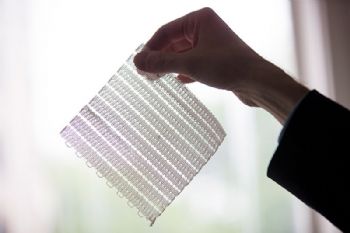
Hearing aids, dental crowns and limb prosthetics are some of the medical devices that can now be digitally designed and customised for individual patients, thanks to 3-D printing.
However, these devices are typically designed to replace or support bones and other rigid parts of the body, so they are often printed from materials that are solid and relatively inflexible.
However, MIT (Massachusetts Institute of Technology) engineers have designed pliable 3-D printed mesh materials with a flexibility and toughness that they can ‘tune’ to emulate and support softer tissues such as muscles and tendons.
They can tailor the intricate structures in each mesh, and they envision the tough yet stretchy fabric-like material being used as personalised wearable supports (including ankle or knee braces) and even implantable devices (such as hernia meshes) that better match to a person’s body.
As a demonstration, the team printed a flexible mesh for use in an ankle brace.
They tailored the mesh’s structure to prevent the ankle from turning inwards — a common cause of injury — while allowing the joint to move freely in other directions.
The researchers also fabricated a knee brace design that could conform to the knee even as it bends.
Sebastian Pattinson, who conducted the research at MIT (
www.mit.edu) and was the lead author of a study published in the journal Advanced Functional Materials, said: “This work focuses on the mechanical properties and geometries required to support soft tissues . . . 3-D-printed clothing and devices tend to be very bulky, so we were trying to think of how we can make 3-D-printed constructs more flexible and comfortable, like textiles and fabrics.”
Mr Pattinson and team members ‘found inspiration’ in collagen, the structural protein that makes up much of the body’s soft tissues and is found in ligaments, tendons and muscles.
Under a microscope, collagen can resemble curvy intertwined strands, similar to loosely braided elastic ribbons.
When asked to stretch, this collagen initially does so easily, as the kinks in its structure straighten out.
But once taut, the strands are harder to extend.
Mr Pattinson designed wavy patterns, which he 3-D-printed using thermoplastic polyurethane as the printing material.
Moreover, the taller he designed the waves, the more the mesh could be stretched at ‘low strain’ before becoming more stiff — a design principle that can help to tailor a mesh’s degree of flexibility and help it to mimic soft tissue.